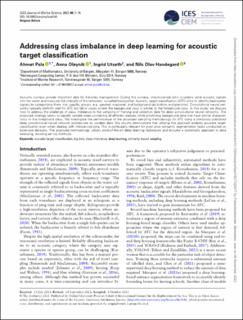| dc.contributor.author | Pala, Ahmet | |
| dc.contributor.author | Oleynik, Anna | |
| dc.contributor.author | Utseth, Ingrid | |
| dc.contributor.author | Handegard, Nils Olav | |
| dc.date.accessioned | 2024-01-18T09:49:41Z | |
| dc.date.available | 2024-01-18T09:49:41Z | |
| dc.date.created | 2023-10-30T13:19:05Z | |
| dc.date.issued | 2023 | |
| dc.identifier.issn | 1054-3139 | |
| dc.identifier.uri | https://hdl.handle.net/11250/3112408 | |
| dc.description.abstract | Acoustic surveys provide important data for fisheries management. During the surveys, ship-mounted echo sounders send acoustic signals into the water and measure the strength of the reflection, so-called backscatter. Acoustic target classification (ATC) aims to identify backscatter signals by categorizing them into specific groups, e.g. sandeel, mackerel, and background (as bottom and plankton). Convolutional neural networks typically perform well for ATC but fail in cases where the background class is similar to the foreground class. In this study, we discuss how to address the challenge of class imbalance in the sampling of training and validation data for deep convolutional neural networks. The proposed strategy seeks to equally sample areas containing all different classes while prioritizing background data that have similar characteristics to the foreground class. We investigate the performance of the proposed sampling methodology for ATC using a previously published deep convolutional neural network architecture on sandeel data. Our results demonstrate that utilizing this approach enables accurate target classification even when dealing with imbalanced data. This is particularly relevant for pixel-wise semantic segmentation tasks conducted on extensive datasets. The proposed methodology utilizes state-of-the-art deep learning techniques and ensures a systematic approach to data balancing, avoiding ad hoc methods. | en_US |
| dc.language.iso | eng | en_US |
| dc.publisher | Oxford University Press | en_US |
| dc.rights | Navngivelse 4.0 Internasjonal | * |
| dc.rights.uri | http://creativecommons.org/licenses/by/4.0/deed.no | * |
| dc.title | Addressing class imbalance in deep learning for acoustic target classification | en_US |
| dc.type | Journal article | en_US |
| dc.type | Peer reviewed | en_US |
| dc.description.version | publishedVersion | en_US |
| dc.rights.holder | Copyright 2023 The Author(s) | en_US |
| cristin.ispublished | true | |
| cristin.fulltext | original | |
| cristin.qualitycode | 2 | |
| dc.identifier.doi | 10.1093/icesjms/fsad165 | |
| dc.identifier.cristin | 2189996 | |
| dc.source.journal | ICES Journal of Marine Science | en_US |
| dc.source.pagenumber | 2530–2544 | en_US |
| dc.relation.project | Norges forskningsråd: 309512 | en_US |
| dc.identifier.citation | ICES Journal of Marine Science. 2023, 80 (10), 2530–2544. | en_US |
| dc.source.volume | 80 | en_US |
| dc.source.issue | 10 | en_US |

